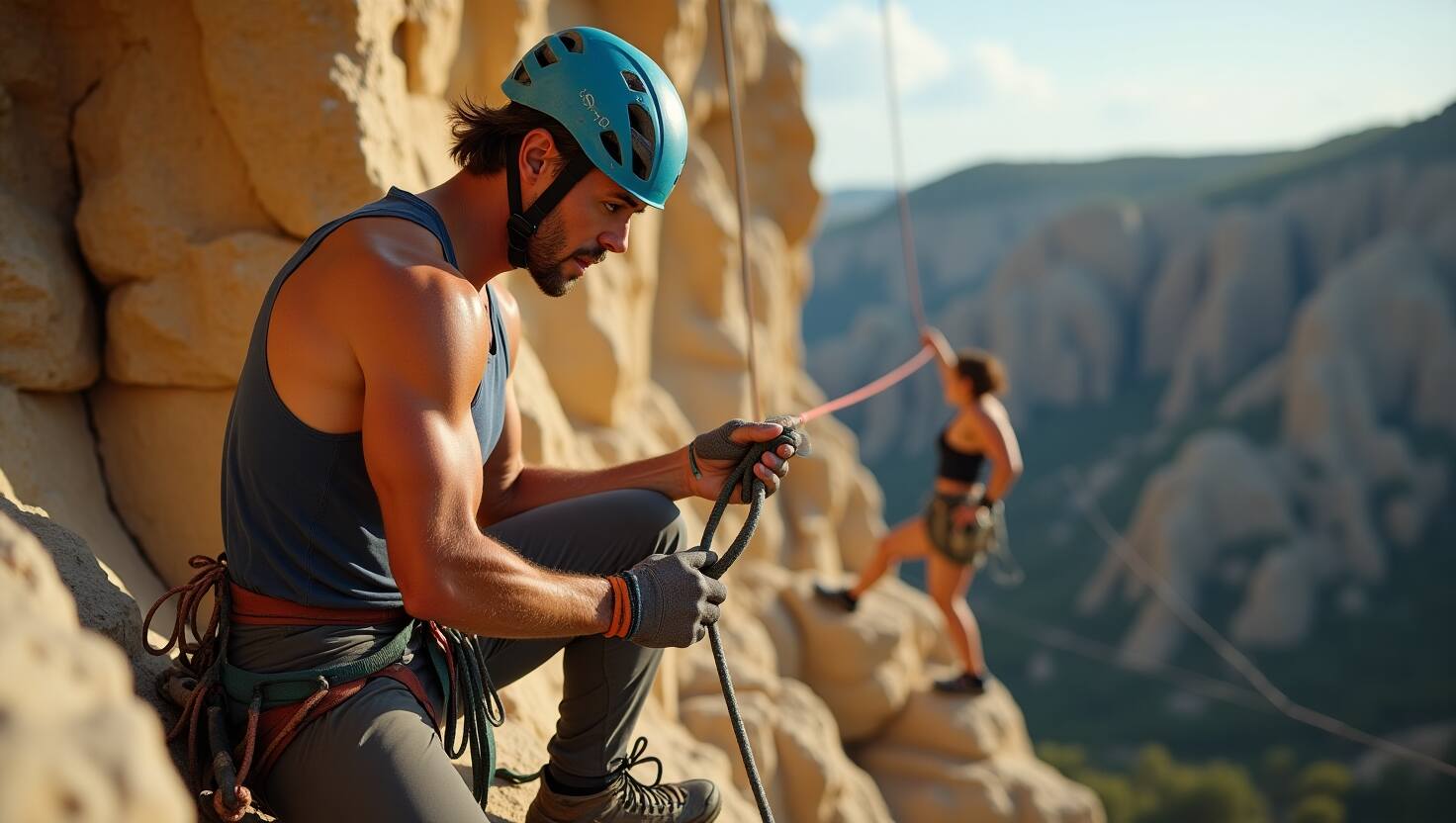The first time I stood at the base of a climbing wall, rope in hand, ready to belay a friend leading the route, my heart raced. The responsibility felt immense—keeping my partner safe while they clipped quickdraws and pushed their limits.
If you’re a beginner stepping into lead belaying, that mix of excitement and nerves is normal. Lead belaying is a critical skill for climbers transitioning to lead climbing, but it comes with greater risks than top rope belaying. With proper training, though, you can master it safely and confidently.
This guide walks you through how to lead belay safely, offering a clear, step-by-step approach tailored for beginners. From essential gear to common mistakes and confidence-building tips, we’ll cover everything you need to know. Let’s dive in and ensure your next climb is both thrilling and secure.
Understanding Lead Belaying: A Beginner’s Overview
Lead belaying is a dynamic process where the belayer manages the rope as the climber ascends, clipping it into quickdraws attached to the wall or rock. Unlike top rope belaying, where the rope is anchored above, lead belaying involves feeding out slack and preparing for potential falls, making it more complex and riskier. According to the American Alpine Club’s 2023 report, belaying errors contribute to roughly 20% of climbing injuries, with lead belaying posing a higher risk due to fall dynamics.
Why does safety matter? A single mistake—like giving too little slack—can lead to dangerous falls. For example, a 2021 incident at Red River Gorge saw a climber sprain an ankle because the belayer didn’t provide enough slack during a clip, causing an awkward fall. Understanding the stakes sets the foundation for safe lead belaying.
Here’s a quick comparison of lead belay vs. top rope belay:
| Aspect | Lead Belay | Top Rope Belay |
|---|---|---|
| Rope Setup | Rope clipped into quickdraws as climber ascends | Rope anchored at top of route |
| Fall Dynamics | Dynamic falls; longer fall distances | Short, controlled falls |
| Skill Level | Intermediate; requires active rope management | Beginner-friendly; simpler technique |
| Gear | Brake-assist or tubular belay device | Tubular belay device often sufficient |
Must-Have Lead Belay Gear: What You Need to Get Started
Before you belay, ensure you have the right equipment. The right gear not only enhances safety but also boosts your confidence. A 2024 Petzl survey found that 65% of beginner lead belayers prefer brake-assist devices for their added security. Here’s what you’ll need:
- Belay Device: Options include brake-assist devices (e.g., Petzl Grigri) or tubular devices (e.g., Black Diamond ATC). Grigris are ideal for beginners due to their auto-locking feature.
- Locking Carabiner: A sturdy, UIAA-certified carabiner to connect the belay device to your harness.
- Harness: A comfortable, well-fitted climbing harness for both belayer and climber.
- Climbing Rope: A dynamic rope (9.5–10.2mm diameter) designed for lead climbing, certified by UIAA or CE standards.
- Optional: A ground anchor if the belayer is significantly lighter than the climber to prevent being lifted during a fall.
Gear Comparison:
| Belay Device | Pros | Cons | Price Range |
|---|---|---|---|
| Petzl Grigri | Auto-locking, beginner-friendly | More expensive, heavier | $100–$130 |
| Black Diamond ATC | Lightweight, affordable | Requires more skill, no auto-lock | $20–$30 |
Safety Tip: Always inspect gear for wear and ensure it meets international safety standards. A faulty device or rope can compromise safety.
How to Lead Belay: 6 Essential Steps for Beginners
Mastering lead belaying requires precision and focus. Follow these six steps to ensure a safe and smooth climb, informed by REI’s expert advice and AMGA standards.
- Pre-Climb Safety Checks
Before climbing begins, perform thorough checks:- Verify the climber’s knot (figure 8 with a stopper knot).
- Ensure both harnesses are secure and doubled back.
- Confirm the belay device is correctly threaded and locked.
- Check for a ground anchor if needed.
AMGA instructors recommend a partner check system: “Knots, harness, device, anchor.” A 2023 study by the American Alpine Club found that proper checks reduce injury risk by 50%.
- Effective Communication
Clear communication prevents confusion. Use standard commands:- “Slack!” (climber needs more rope).
- “Clipping!” (climber is attaching rope to a quickdraw).
- “Take!” (climber needs tension).
- “Falling!” (prepare to catch).
AMGA instructor Naz Ahmed advises shouting commands loudly, especially in noisy gyms or windy crags. Agree on commands before the climb starts.
- Rope Management
Proper rope handling is critical.- Flake the rope before climbing to avoid tangles.
- Feed slack smoothly as the climber moves, keeping just enough to prevent dragging but not so much as to risk a long fall.
A 2021 Red River Gorge incident highlighted the dangers of short-roping (too little slack), which caused an injury. Practice dynamic slack management in a gym.
- Proper Positioning
Your stance impacts safety.- Stand directly below the climber’s route to minimize pendulum falls.
- Keep knees slightly bent and stay alert to react quickly.
- If you’re much lighter than the climber, use a ground anchor to stay grounded, as advised by AMGA instructor Matt Vodjansky.
- Catching Falls
Lead climbing involves dynamic falls, so be prepared.- For short falls, use a soft catch by feeding slight slack to reduce impact.
- For longer falls, use a hard catch by locking off the rope quickly.
- Practice catching mock falls in a gym, as REI Outdoor School clinics reduced errors by 70% through hands-on training.
- Lowering the Climber
When the climber reaches the top or needs to descend:- Ensure enough rope remains for a smooth lower.
- Lower gradually, keeping the brake hand engaged to avoid sudden drops.
Petzl recommends practicing lowering techniques with a partner to build muscle memory.
Visual Aid: Include a diagram showing proper rope flaking and belay stance for clarity.
Top 5 Lead Belaying Mistakes Beginners Make
Even with the best intentions, beginners can make errors that compromise safety. Here are five common mistakes and how to avoid them, based on Climbing Magazine insights and AMGA guidelines.
- Giving Incorrect Slack
- Problem: Too much slack risks long falls; too little causes short-roping, dragging the climber down.
- Solution: Practice dynamic slack management in a controlled setting. Watch the climber’s movements to anticipate clipping.
- Removing Brake Hand
- Problem: Taking your brake hand off the rope can lead to uncontrolled falls.
- Solution: Always keep your brake hand on the rope, as emphasized by AMGA standards. Use a brake-assist device for added security.
- Getting Distracted
- Problem: Checking your phone or chatting can cause you to miss a fall. A 2025 gym incident saw a distracted belayer fail to catch a fall, resulting in a minor injury.
- Solution: Stay focused on the climber at all times. Treat belaying as a full-time responsibility.
- Incorrect Belay Device Setup
- Problem: Threading the rope incorrectly can render the device useless.
- Solution: Double-check the setup against manufacturer instructions (e.g., Petzl’s Grigri manual).
- Poor Communication
- Problem: Misheard or unclear commands lead to confusion.
- Solution: Agree on commands pre-climb and practice shouting them clearly, as advised by Naz Ahmed.
How to Build Confidence in Lead Belaying: Tips for Beginners
Lead belaying can feel daunting, but confidence comes with preparation and practice. A Reddit user on r/climbing (2024) shared how they overcame fear by practicing mock belays in a gym, and you can too. Here’s how:
- Mental Preparation: Visualize the process—checking gear, feeding slack, catching falls—to reduce anxiety. Rock and Ice (2022) suggests visualization as a powerful tool for climbers.
- Practice Drills: Start with mock lead belays in a gym, where you simulate falls with a top rope backup. REI Outdoor School found that hands-on practice cuts errors by 70%.
- Build Partner Trust: Clear communication and consistent practice foster trust, as noted by climbing legend John Long in Climbing Anchors.
- Take a Course: Enroll in a belay clinic (e.g., REI or AMGA programs) for expert feedback and structured learning.
One beginner, Sarah, shared on Reddit how she went from trembling during her first lead belay to confidently belaying her partner outdoors after three gym sessions. Her secret? Repetition and a supportive climbing partner.
Your Lead Belaying Safety Checklist: 10 Must-Do Steps
A safety checklist ensures nothing is overlooked. Keep this handy for every climb:
- Verify climber’s figure 8 knot with a stopper knot.
- Check both harnesses are secure and doubled back.
- Ensure belay device is correctly threaded and locked.
- Confirm ground anchor (if needed) is secure.
- Agree on communication commands.
- Inspect rope for tangles and flake it properly.
- Check gear for wear or damage.
- Position yourself directly below the climber’s route.
- Assess weight differences and fall dynamics.
- Stay focused throughout the climb.
Start Lead Belaying Safely Today
Lead belaying is a rewarding skill that opens the door to lead climbing adventures. By following these six steps—pre-climb checks, clear communication, proper rope management, correct positioning, catching falls, and smooth lowering—you’ll keep your climber safe and build your confidence. Avoid common mistakes like incorrect slack or distraction, and use our safety checklist to stay on track.
Ready to take the next step? Join a local climbing gym to practice, enroll in a belay course for expert guidance, or explore our gear guide to find the best equipment for your needs. Start your lead belaying journey today and climb with confidence!





[…] the figure 8 knot can feel intimidating, especially for safety-critical activities like climbing. These tips, inspired by VDiff Climbing and climbing forums, help beginners build confidence and […]